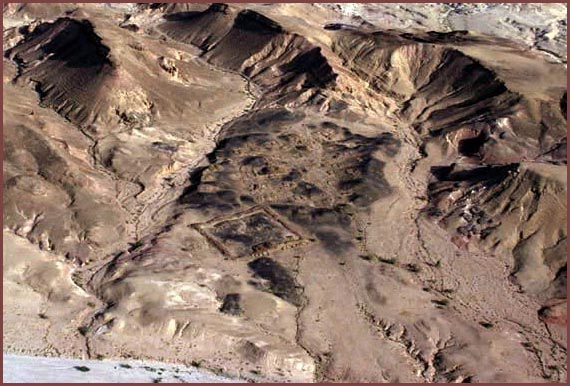Bibliographical Test for Historical Accuracy and Reliability
Twentieth Century Discoveries
Dead Sea Scrolls
The Golden Age
Babylonian Exile
The Cyrus Cylinder
Nehemiah's Wall
The Kings of Judah
The Uzziah Tablet
Seal of Shebnayah, Servant of Uzziah
King Jotham and his son King Ahaz - 750-715 BC
King Hezekiah - 715-686 BC
King Manasseh - 695-642 BC
King Jehoiachin - 597 BC
King Zedekiah - 597-586 BC
The Kings of Israel
King Omri - 885-874 BC
King Ahab - 874-853 BC
King Jehu - 841-814 BC
King Joash (Jehoash) - 798-782 BC
King Jeroboam II - 793-753 BC
King Menahem 752-742 BC; King Pekah - 740-732 BC, and King Hoshea - 732-724 BC
Jesus
Caiaphas
The James Ossuary
The Pool of Siloam
The Future of the Past
Bible Genealogy Home
Marshall Genealogy Home
Last updated May 1, 2015
Introduction
This website is far from finished. I decided to upload it in its incomplete stage and continue adding additional archaeological discoveries as quickly as I can assimilate them. There is much yet that needs to be added.I began to envision this page mentally on March 7, 2011. That was the day I received an email message from a person in England who took exception with the information on my Bible Genealogy site. He commented that Americans seemed willing to believe anything and that the Bible is widely regarded by most people as a collection of "fables and fairy tales." I still have that email message and it eventually moved me to create this webpage and add it to my Bible Genealogy website.
There is another reason I was moved to create this website. Beginning in the 1970s a group of "Biblical Scholars" sought to discredit the Bible as a book of fables. They claimed that King David and Solomon never existed as great kings and that their entire history was made up by Jewish writers to give themselves a "Golden Age" history. These "scholars" are widely referred to as "Biblical Minimalists." However, since the middle 1900s there has been a tsunami of activity in archaeological discoveries related to the Bible. Because of these new discoveries the minimalists have largely retreated or begun to distance themselves from their previous positions about the Bible as history.
So, I pose a question to you. Is the Bible a reliable source or is it, as the minimalists so colorfully put it, "a collection of fables and fairy tales?" I thought I would offer you some insights into that question. This webpage seeks to offer archaeological evidence to those who need it, that far from being a book of fables and fairy tales, the Bible contains events that are historical in nature as well as theological. Hopefully, you will find the things on this page interesting, and maybe even educational. Perhaps it will even induce you to look a little deeper into things that are in the Bible. I promise that I will not preach to you or attempt to convert you. I simply want to provide you with data that speaks to the reliable of the Bible.
Here are some interesting quotes from Brother Guy Consolmagno, an American research astronomer and planetary scientist at the Vatican Observatory.
- Science doesn’t prove. Science describes.
- The Bible isn’t a book of propositions to be proved or disproved; it’s a conversation about God. So that question presupposes a radically false idea of what science is, and what the Bible is.
- To apply a modern reading to a 2,000-year-old text “does violence to the text,” Consolmagno said, “and that’s not me saying it, it’s Augustine saying it.”
- Science and religion are not about definitive answers. They are conversations about questions that stay with you all your life.
Back to top
Bibliographical Test for Historical Accuracy and Reliability
Let's start with a very basic premise about the reliability of any ancient document. There are a number of things that document experts consider when they determine whether or not a document is an accurate and reliable source. For example they examine the material on which the text is inscribed and the context in which the text was found. If it was a stone inscription, where was it found and what other inscriptions are around it that shed light on the context? If it is papyrus or vellum does the material pass the carbon dating test for authenticity? If it is pottery, does the style of the pottery match the style of other pottery found nearby.Another test is the style of writing. Do the characters (or pictures) match what is known about that style of writing during that particular time period. The shapes and styles of individual characters change over time and are a great help in precisely dating a particular text.
Another important indicator of accuracy is how many ancient copies of the source documents for a document, such as the Bible, exist and how close were these source documents written to the time period that the actions took place.
The table below shows a sample group of ancient documents that are considered to be credible. No document from antiquity enjoys as excellent an array of textual and historical testimonies as the New Testament.
"The New Testament is better attested by ancient manuscripts that any other piece of ancient literature." - Douglas Groothuis, Associate Professor of Philosophy of Religion Department at Denver Seminary.
| Textual Transmission of Ancient Documents | ||||
|---|---|---|---|---|
| Event or Writing | Original | Oldest Copy | Time Gap | Manuscripts |
| The History of the Peloponnesian War - Thucydides | 460-400 BC | 900 AD | 1,300 Years | 8 |
| Aristotle Poetics | 343 BC | 1100 AD | 1,400 Years | 49 |
| History of the Gaelic Wars - Caesar | 58-50 BC | 1050 AD | 1,000 Years | 9 |
| Annals of Imperial Rome - Tacitus | 116 AD | 850 AD | 734 Years | 1 |
| Josephus | 1st Century AD | 10th Century AD | 900 Years | 9 |
| Iliad (Trojan War) - Homer | 7th Century BC | 1488 AD | 2,100 Years | 643 |
| New Testament | 1st Century | 1st Century | 50 Years | 20,000 |
Twentieth Century Discoveries
Before I start I want to acquaint you with an archaeology axiom. "Absence of evidence is not necessarily evidence of absence." It sometimes means that we just haven't found it yet. In recent years, since 1947 to be exact, hundreds of archaeological discoveries have uncovered thousands of artifacts that speak directly to the reliability of the Bible. I will present a few of those discoveries here for you to ponder. These discoveries are well documented and I will be glad to furnish copies of the published documents if you wish. The rest is up to you.
Back to top
Old Testament Archaeology
I will start with the Dead Sea Scrolls that were discovered in 1947. Fragments of 900 scrolls were brought out of the caves at Qumran during the years immediately following 1947. They were written from about 250 BCE until about 100 BCE. It is the single greatest archaeological discovery of the 20th century. 200 of the scrolls are manuscripts of the ancient Hebrew Bible (Old Testament). Every book of the Old Testament is represented in these ancient scrolls except for the book of Esther. 700 of the scrolls were things other that the Bible. For example one of the scrolls is called "Rules of the Community." That scroll and all of the other 700 non-biblical scrolls give us great insight into the lives of those ancient Jews. In turn that provides a "context" for our understanding of the early roots of Christianity. There is much more I could say about that, but it is best left to a future discussion.


Back to top
The Golden Age
The Golden AgeNow let's look at the so called "golden age of Saul, David and Solomon." The Bible contains glorious stories of the great kingdom of the Hebrews that existed at that time. (Approximately 1,000 years before the birth of Christ.) During the 1970s and 1980s several "Biblical Scholars" (They are commonly called Biblical minimalists.) flatly stated that it was all just a made up story and that David never existed. Or at least that he was never a great king that ruled over a large kingdom. They reasoned that there was absolutely nothing outside the Bible to support such a claim by the Bible. (Absence of evidence) These scholars had a merry time with that until 1992 or 1993. At that time an archaeologist published that he found a stone building block in the ancient ruins of Dan that had the following clear inscription written on it: "…The House of David.." The king who ruled in that area had built a monument depicting a war he had conducted against Kind David.

Back to top
Babylonian Exile
The Cyrus Cylinder
In Ezra 1:1-4 we find the following scripture:
Ezr 1:1 In the first year of Cyrus king of Persia, in order to fulfill the word of the LORD spoken by Jeremiah, the LORD moved the heart of Cyrus king of Persia to make a proclamation throughout his realm and to put it in writing:
Ezr 1:2 “This is what Cyrus king of Persia says: “ ‘The LORD, the God of heaven, has given me all the kingdoms of the earth and he has appointed me to build d a temple for him at Jerusalem in Judah.
Ezr 1:3 Anyone of his people among you—may his God be with him, and let him go up to Jerusalem in Judah and build the temple of the LORD, the God of Israel, the God who is in Jerusalem.
Ezr 1:4 And the people of any place where survivors may now be living are to provide him with silver and gold, with goods and livestock, and with freewill offerings for the temple of God in Jerusalem.’ ”
In 1879 an ancient clay cylinder was discovered in Babylon that dates back to the 6th century BC and King Cyrus. Included in the inscription on the cylinder is the following text from lines 31 and 32 on the cylinder.
From [?] to Aššur and [from] Susa, Agade, Ešnunna, Zamban, Me-Turnu, Der, as far as the region of Gutium, the sacred centers on the other side of the Tigris, whose sanctuaries had been abandoned for a long time, I returned the images of the gods, who had resided there [i.e., in Babylon], to their places and I let them dwell in eternal abodes. I gathered all their inhabitants and returned to them their dwellings.
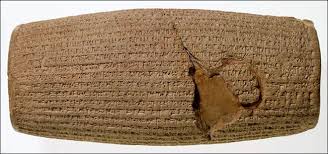
The Cyrus Cylinder is a striking example of an archaeological discovery that independently confirms a Biblical account. The 9-inch cylinder is on display at the British Museum in London.
Back to top
Nehemiah's Wall
The exile occurred in 585 & 586 BCE. About 50 years later a man named Nehemiah returned to Jerusalem and rebuilt the city walls in 52 days. Read the book of Nehemiah for the details of this "fable." Once again recent archaeology finds shed light on this story. Just a few years ago an archaeologist found a portion of the wall in Jerusalem that Nehemiah built. How they determined that Nehemiah built that wall and how it supports the assertion in the Bible that it was built in 52 days is a long, technical discussion. I can supply that documentation for you if you wish. One of the things that supports the 52-day building period was because the wall is very poorly built. One might say that it was literally "thrown up."
The picture below shows the location of a short piece of the wall. The second image below locates the actual position of the wall. The third picture below shows where the piece of wall is located in relation to the temple mound today.

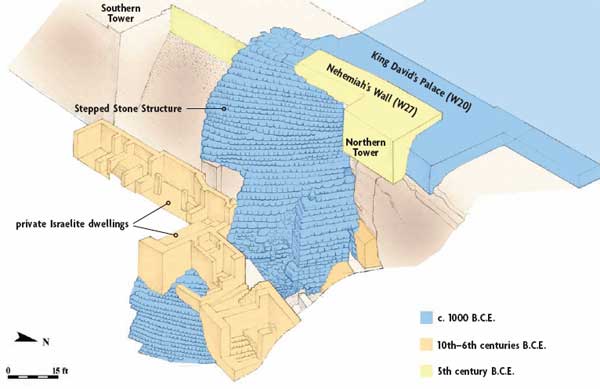
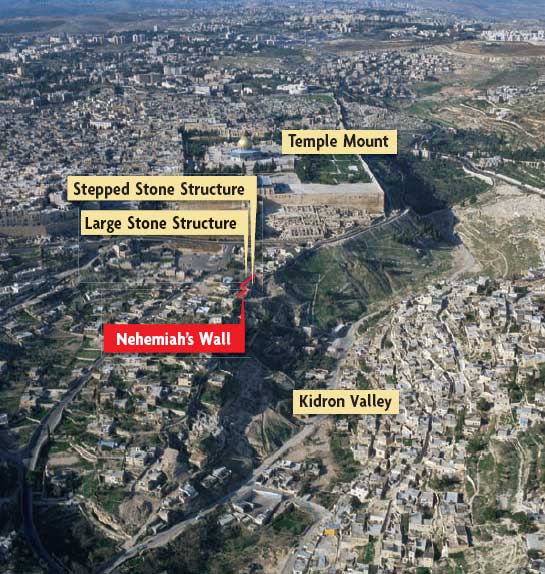
Back to top
The Kings of Judah and Israel
The Kings of Judah (Southern Kingdom)
The Uzziah Tablet - 790-739 BC
Uzziah was also known as Azariah - 2 Kings 15:1-7
In 1931 an archeological find, now known as the Uzziah Tablet was discovered by Professor E.I. Sukenik of the Hebrew University of Jerusalem.
The Funerary Inscription of King Uzziah was found in the collection of the Russian Convent on the Mount of Olives. The Aramaic inscription is incised on a stone tablet (35 x 34 cm.) and the style of the script dates it to the latter part of the Second Temple period. It tells of the reburial of the remains of Uzziah, King of Judah. The Inscription on the Uzziah Tablet reads: "Hither were brought the bones of Uzziah, King of Judah and do not open" (Leprosy).
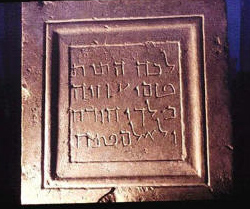
This reddish-brown, oval-shaped stamped seal has two convex sides, each containing a different carving. The scene on one side depicts a man wearing a long garment, possibly of Assyrian style, and holding a staff or scepter in his left hand. His right arm is raised. The Hebrew inscription behind him reads “Belonging to Shebnayau.” The carving on the other side has two winged solar discs, one at the top and one at the bottom. Between the two discs is a two-line inscription that reads, “Belonging to Shebnayau, servant of Uzziah.” The term “servant” was commonly used as a title for a high royal official. It is very possible that this “Shebna” is the same man described in Isaiah 22:15 as a “steward over his masters house” – (During the reigns of King Uzziah and King Hezekiah)
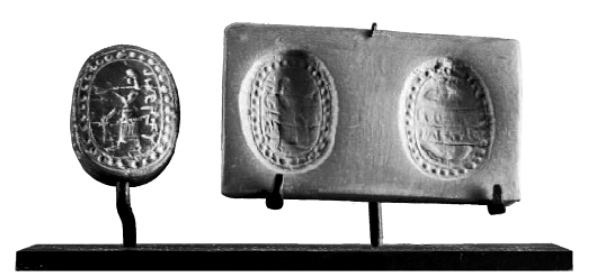
King Jotham and his son King Ahaz - 750-715 BC - 2 Kings 15:38-16:20
One of the bulla has the name of King Ahaz on it. It also has the name of his father, King Jotham on it. Ahaz was the king that ruled in Jerusalem during the time of Isaiah. He was the king to whom Isaiah proclaimed in Isaiah 7:14.
Isa 7:15 He will eat curds and honey when he knows enough to reject the wrong and choose the right. The bulla doesn't, by itself, prove that Isaiah said that to Ahaz. But it does prove that Ahaz did exist and was King in Jerusalem as stated in the Bible. Amazingly, there is a thumb print on the left side of the bulla. It could well be the thumb print of King Ahaz. It also might be the print of one of his officials who actually sealed the document.

Below are two samples of bulla containing the name of Hezekiah, who was the son of Ahaz. He was the king who built Hezekiah's tunnel that connected the city of Jerusalem to a secure water source outside the city walls. The one on the right was discovered in the Ophel excavations led by Dr. Eilat Mazar at the foot of the southern wall of the Temple Mount in Jerusalem. These, along with thousands of other bulla prove that there was a line of kings in Israel and Judah as stated in the Bible.
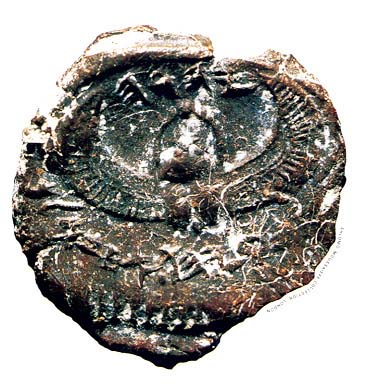
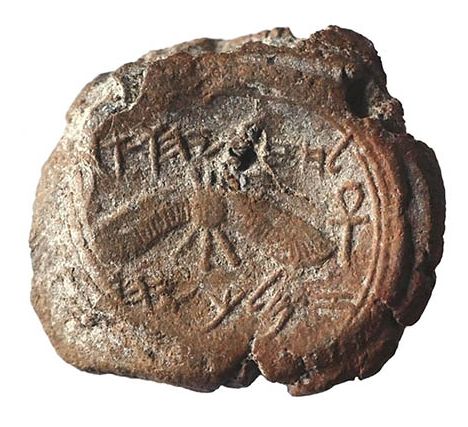
An artifact has been found in the annals of archaeology that bears witness to Manasseh, who was the son of king Hezekiah.
Manasseh, who also became king of Judah, is mentioned by the Assyrian king Esarhaddon who reigned 680 years before Christ. The inscription lists kings who were under his submission as contributing materials to furnish his royal palace. It reads as follow:
“I commanded the kings from the region of Hatti as well as the areas on the other side of the Euphrates, including Ba‘lu, king of Tyre, Manasseh, king of Judah . . . ; a total of 22 kings from Hatti, the seashore and islands, all of them were given the difficult task of transporting building materials to my palace in Nineveh, the city over which I am king.”
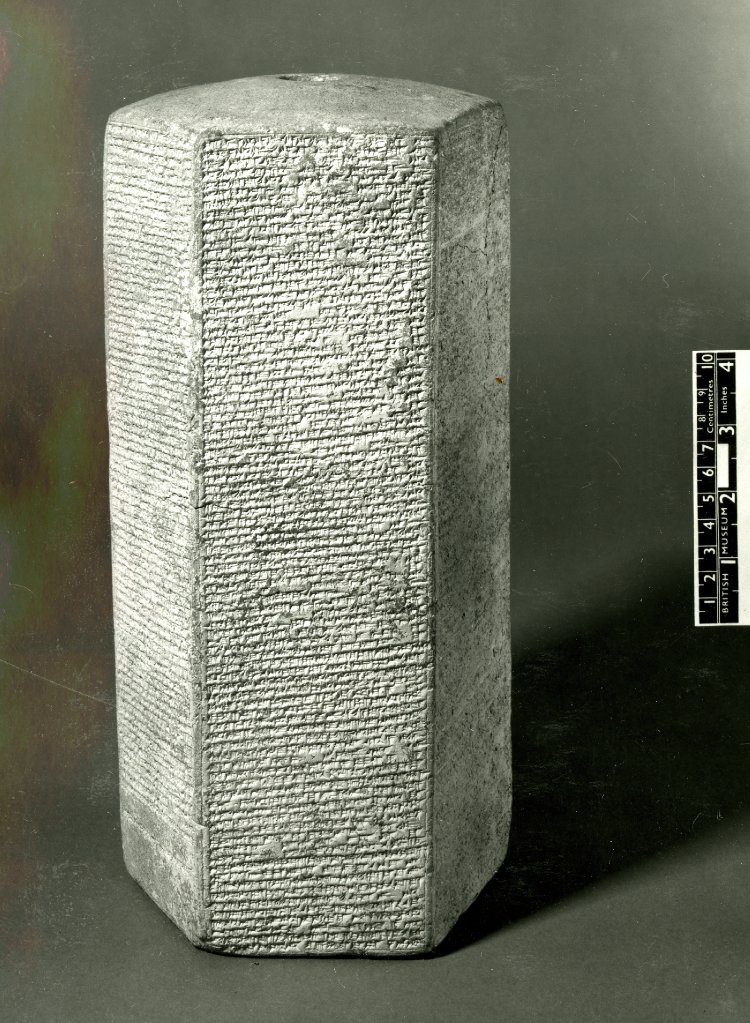
Back to top
King Jehoiachin - 597BC - 2 Kings 24:8-17
Administrative tablets from the royal archives of Nebuchadnezzar king of Babylon have been unearthed in the ruins of Babylon. Some of the tablets contain food rations paid to captives and craftsmen who lived in and around the city. On one of the tablets, "Yaukin, king of the land of Judah" is mentioned along with his five sons listed as royal princes. The image below shows one of the tablets in the archive. Below the image are a few inscriptions found on two of the tablets:
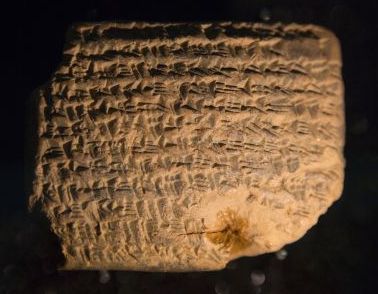
10 (sila of oil) to the king of Judah, Yaukin.
2 1/2 sila (oil) to the offspring of Judah’s king,
4 sila to eight Judean men....
(Babylon 28186, reverse ii 13-18)
1 1/2 sila (oil) for three wood workers from Arvad, 1/2 sila each,
11 1/2 sila for eight wood workers from Byblos, . . .
3 1/2 sila for seven Greek craftsman, 1/2 sila apiece,
1/2 sila to the carpenter, Nabuetir
10 sila to Ia-ku-u-ki-nu, the king of Judah’s son,
2 1/2 sila for the five sons of the Judean king
This evidence corresponds well with the Biblical text found in II Kings 24:10-17 which says:
2Ki 24:10 At that time the officers of Nebuchadnezzar king of Babylon advanced on Jerusalem and laid siege to it,
2Ki 24:11 and Nebuchadnezzar himself came up to the city while his officers were besieging it.
2Ki 24:12 Jehoiachin king of Judah, his mother, his attendants, his nobles and his officials all surrendered s to him. In the eighth year of the reign of the king of Babylon, he took Jehoiachin prisoner.
2Ki 24:13 As the LORD had declared, Nebuchadnezzar removed all the treasures from the temple of the LORD and from the royal palace, and took away all the gold articles that Solomon king of Israel had made for the temple of the LORD.
2Ki 24:14 He carried into exile all Jerusalem: all the officers and fighting men, and all the craftsmen and artisans—a total of ten thousand. Only the poorest people of the land were left.
2Ki 24:15 Nebuchadnezzar took Jehoiachin captive to Babylon. He also took from Jerusalem to Babylon the king’s mother, his wives, his officials and the leading men of the land.
2Ki 24:16 The king of Babylon also deported to Babylon the entire force of seven thousand fighting men, strong and fit for war, and a thousand craftsmen and artisans.
2Ki 24:17 He made Mattaniah, Jehoiachin’s uncle, king in his place and changed his name to Zedekiah.
Back to top
King Zedekiah - 597-586 BC - 2 Kings 24:17-25:7
The first thing we should say about Zedekiah is that his name appearss on one of the Babylonian administrative tablets mentioned above.
In Jeremiah 38:1-13 two men are mentioned together as ministers of King Zedekiah. Their names are Gedaliah son of Pash?ur and Jucal son of Shelemiah. During the excavation of Nehemiah's wall two small bulla (seal impressions) were found with their names on them.
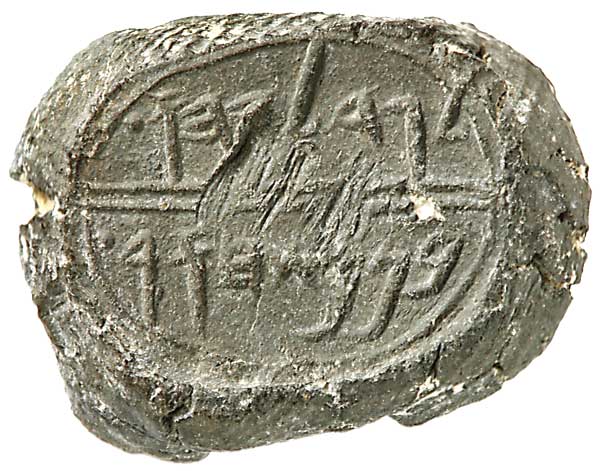
| 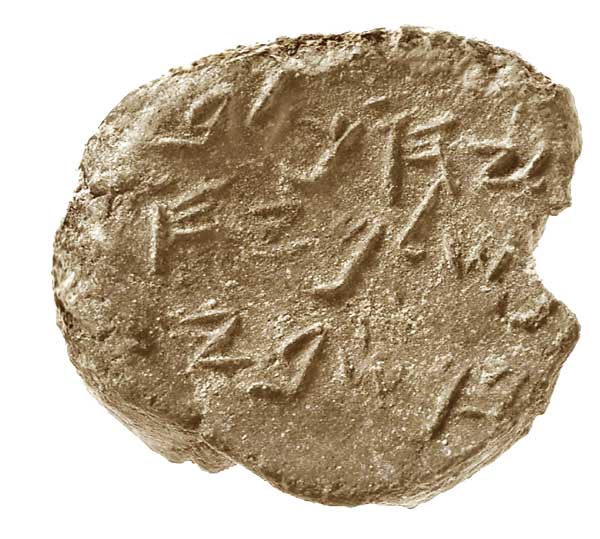
|
Back to top
The Kings of Israel (Northern Kingdom)
King Omri - 885-874 BC - 1 Kings 16:16-17
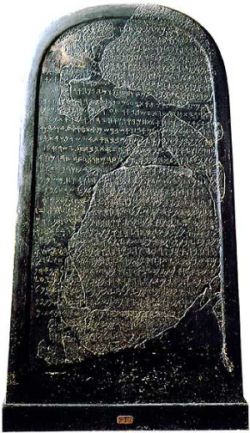
Omri had taken possession of the land of Medeba. And he dwelt in it in his days and half [2] the days of his son [3]: 40 years; but Chemosh restored it in my days (lines 7-9).
The Mesha Inscription not only mentions Mesha, king of Moab, known in the Bible, but also Omri, one of the most powerful kings of the Northern Kingdom (1 Kgs. 16:21-28), who ruled 885-874 BC.
King Ahab - 874-853 BC - 1 Kings 16:28-34
On this stele Shalmaneser III, king of Assyria referred to "Ahab the Israelite."

King Jehu - 841-814 BC - 1 Kings 19:16
This obelisk, which dates to ca. 840 BCE, contains pictures and texts documenting Assyria's triumphs under King Shalmaneser III. One panel depicts Jehu, the Israelite usurper king, kneeling before Shalmaneser. This is the only known ancient depiction of an Israelite king. The accompanying text translates: "Tribute of Jehu, son of Omri. I received from him: silver, gold, a golden bowl, a golden beaker, golden goblets, pitchers of gold, lead, staves for the hand of the king, javelins." The obelisk was discovered Calah in 1846 by Sir Austen Henry Layard, and now resides in the British Museum in London.
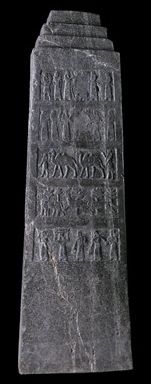 | 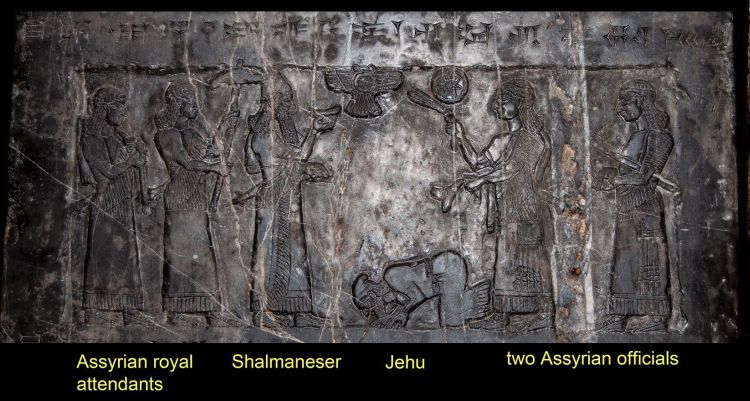 |
King Joash (Jehoash) - 798-782 BC - 2 Kings 13:9
The image below is a Stele of the Assyrian King Adad-Nirari III. It reports on the King's victorious campaignj against Palestine. King Joash's name appears on one panel of the stele.
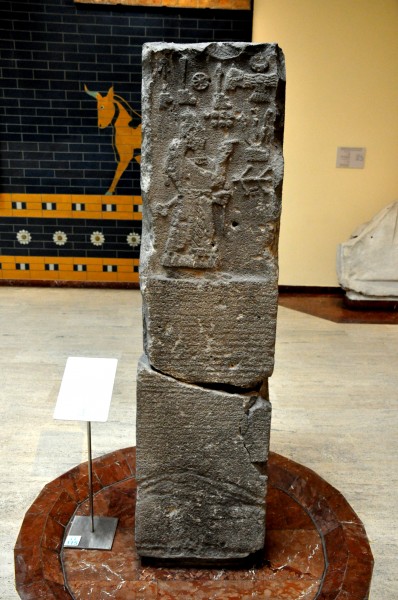
Image License by Osama Shukir Muhammed Amin FRCP (Glasg)
published on 08 April 2014
King Jeroboam II - 793-753 BC - 2 Kings 13:13
This seal was discovered in 1904 during the earliest excavation of Megiddo, led by Gottlieb Schumacher. It belonged to a royal minister "Shema" in the 8th century BC. It is engraved with the figure of a roaring lion (symbol of the kingdom of Judah) with a beautiful curved tail and was skillfully executed. The inscription reads "Shema" on top, and "Servant of Jeroboam" on the bottom.
The inscription actually proclaims the name and rank of its owner, one of the ministers of King Jeroboam II who reigned from 787-747 BC. The word "servant" is the Hebrew word "ebed" and is mentioned in the Bible as one of high dignity in the government.
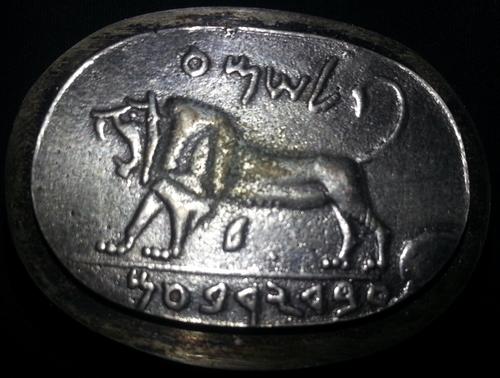
King Menahem 752-742 BC; King Pekah - 740-732 BC, and King Hoshea - 732-724 BC
King Menahem - 2 Kings 15:14-22
King Peka - 2 Kings 15:25-31
King Hoshea - 2 Kings 15:30
The stone slab below is known as the "Calah Inscription." It is the top half of a "summary inscription" of the reign of Adad-nirari III (811 to 783 BC) discovered in 1854 in by William Loftus in his excavations at Nimrud on behalf of the Assyrian Excavation Fund. The translation below refers to King Menahem, King Pekah, and King Hoshea.
[As for Menahem I ov]erwhelmed him [like a snowstorm] and he fled like a bird, alone, [and bowed to my feet(?)]. I returned him to his place [and imposed tribute upon him, to wit:] gold, silver, linen garments with multicolored trimmings,...great...[I re]ceived from him. Israel (lit.: "Omri-Land" Bît Humria)...all its inhabitants (and) their king Pekah (Pa-qa-ha) and I placed Hoshea (A-ú-si-') as king over them.
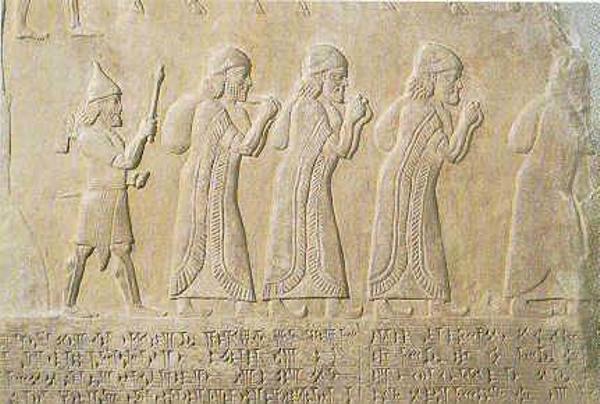 >
>New Testament Archaeology
Jesus
Now let's move into the New Testament. What about Jesus? Did he really exist? You probably already know about the 1st century historian named Flavius Josephus. If not you should read his works. He was a fascinating person and a great historian and one of our most credible sources of first century history. In his book that he called "Antiquities of the Jews" he briefly mentions Jesus as "a holy and just man." I can supply you with the complete quote if you wish. Keep in mind that Josephus was not a follower of Jesus and only knew about his by reputation. Josephus was a Jewish Temple Priest and a devout Jew, not a Christian. The fact that he even mentions Jesus provides weight to the existence of Jesus. There are other things I could mention about proof of Jesus, but it will just make this even longer.Back to top
Caiaphas
Matthew:26:57 - Those who had arrested Jesus took him to Caiaphas, the high priest, where the teachers of the law and the elders had assembled.In the late 1980s an archaeologist found two interesting ossuaries (bone boxes). They have the name of Caiaphas inscribed on the outside. Caiaphas was the High Priest who presided over the trial of Jesus in the Sanhedrin. For the first time in an archaeological context, we now have a form of the name Qafa', or Caiaphas, a name known to us from both the New Testament and from the first-century Jewish historian Flavius Josephus. There is no doubt among archaeologist that this ossuary belongs to Caiaphas and his family.
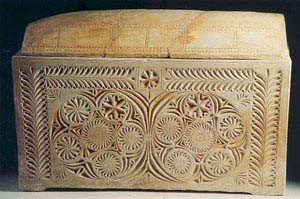
|

|
Back to top
The James Ossuary
On October 21, 2002 in a Washington press conference, co-hosted by The Discovery Channel and the Biblical Archaeology Society the existance of what would become known as The James Ossuary was announced. Inscribed on the side of the ossuary were the words James, son of Joseph, Brother of Jesus. Within a few months
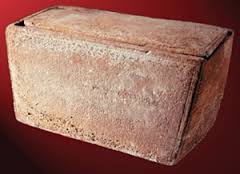 | 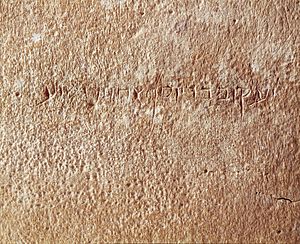 |
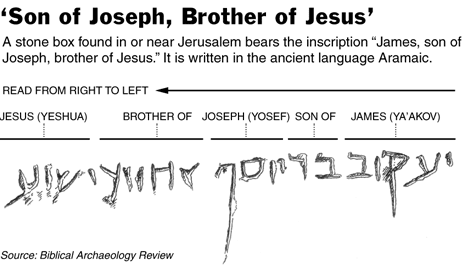
The Pool of Siloam
The story of the Pool of Siloam goes back to King Hezekiah (late 8th - early 7th century BC). Hezekiah had to secure Jerusalem's water supply against a siege by the Assyrian monarch Sennacherib. The only source of water at that time was the Gihon Spring near the floor of the Kidron Valley outside the city walls. Hezekiah dug a 1,700 foot tunnel from the spring, under the ridge, and to the Pool of Siloam on the opposit side of the city. When the exiles returned from Babylon and rebuilt the walls of Jerusalem, Nehemiah tell us that a certain Shallun rebuilt “the wall of the Pool of Shiloah by the King’s Garden” (Nehemiah 3:15). Unfortunately, we still do not know where either of those pools was located. In the Byzantine period the empress Eudocia (c. 400–460 C.E.) built a church and a pool where the water debouches from Hezekiah’s Tunnel to commemorate the miracle of the blind man. Until 2004, it was this pool that people meant when they talked of the Pool of Siloam.In June 2004 archaeologists Eli Shukron was watching a crew of Jerusalem city workers reparing a sewer line in a narrow alley. Suddenly he saw two steps appear. He immediately halted the work and called Ronny Reich, who came rushing down. Ronny identified them as steps going down to the Pool of Siloam during the the Second Temple period (1st century BC - 1st century AD).
This is the pool that figures in the cure of a man who had been blind from birth. Jesus spits on the ground and mixes his saliva with the mud, which he smears on the blind man’s eyes. He then tells the man “to wash in the Pool of Siloam.” When the blind man does so, he is able to see (John 9:1–7).
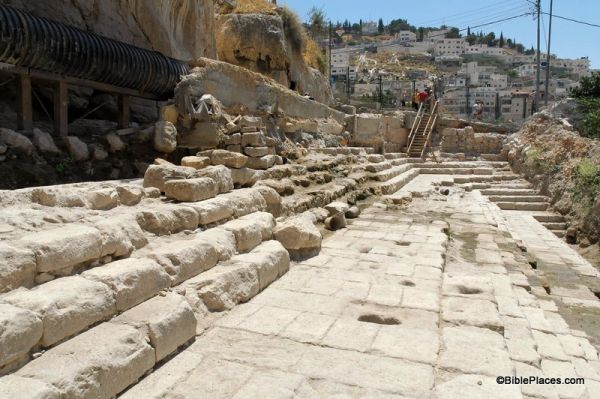
The Future of the Past
Cyber-Archaeology is a 21st century field of science and digital technology that is already changing the face of Biblical Archaeology. I will not try to explain all of the facits of digital archaeology here. For that I refer you to a publication titled Cyber-Archaeology in the Holy Land - The Future of the Past, puiblished by the California Institute for Telecommunications and Information Technology (Calit2), UC San Diego and the Biblical Archaeology Society. What I will include here is one of the astounding projects these scientist conducted that once again proves that the Bible is correct.First, some background is in order for you to fully appreciate the implications of their project conclusions. Traditionally, the age of David and Solomon is dated to the 10th century BC. Biblical "maximalists" accept the timeline in the Bible. On the other hand a group of Biblical "minimalists" argue that since the Bible was only codified 500 years later, anything earlier, such as David and Solomon, is pure myth or at best, they were only petty mafia dons. The minimalists contend that there was no kingdom of David and Solomon or even small states in the Holy Land during the 10th century BC. If that is true then there should be no reflection of state power such as fortresses, administrative centers, or evidence of high levels of production at the state level. As it turned out, this afforded Cyber Archaeology an opportunity to prove its worth to the world of archaeology.
Traditional archaeology depends on the dating of pottery for absolute dating of Iron Age sites. Pottery styles changed over time and are a convenient way of establishing dates. Cyber-Archaeology uses a large number of high-precision radiocarbon data points that are embedded in the stratigraphy of the site to establish dates. Applying these science-based methods is the most objective way to establish the existence or absence of the kingdon of David and Solomon in the 10th century BC as stated in the Bible.
Khirbat en-Nahas "Ruins of Copper"
Khirbat en-Nahas is the largest ancient copper production site in the southeast Mediterranean. It is covered in black mounds of ancient slag. It also includes a massive fortress and remains of public buildings. Before the Cyber-Archaeologists applied their techniques of dating to the site, it was assumed that it dated to about 700 BC or later. It would have nothing to do with early Biblical history such as the kingdom of David and Solomon. By applying the new Cyber-Archaeology digital technology it was proved that the copper mine was in existence in the 10th century BC. This flew in the face of the Biblical minimalist such as Israel Finkelstein. For such an extensive copper production site to function took a high level of organized administration and a high level knowledge of metallurgy. The presence of the massive fort and administration buildings provides futher evidence that the Bible got it right.The image below shows the site of the copper mine. You can see the outline of the fortress at the bottom of the site.
